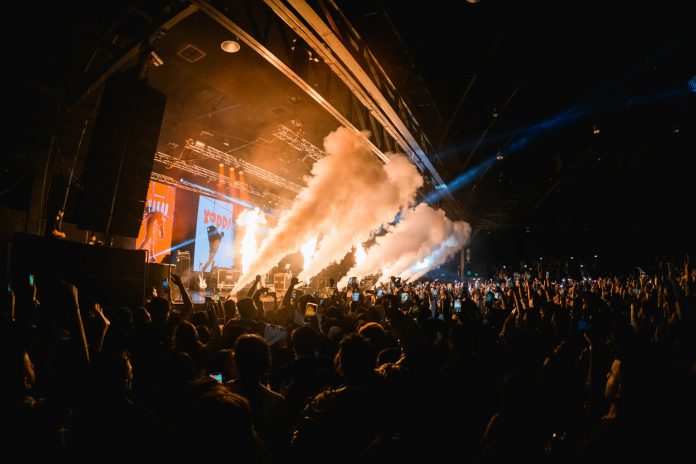There are concerts, and then there are experiences that transcend the boundary between spectacle and storytelling. In 2025, few tours have captured the cultural imagination quite like Celeste Nova’s Elysium World Tour—a traveling fusion of music, science fiction, visual art, and next-gen stagecraft. While critics have praised Nova’s vocals and choreography, it’s the jaw-dropping stage design that has everyone talking.
From the moment the lights dim to the final ovation, the stage itself becomes a dynamic character in the show—shifting, glowing, levitating, and often defying logic. This isn’t just a backdrop for music; it’s a kinetic canvas designed to immerse, provoke, and elevate the senses. The Elysium tour’s design is both a technical marvel and a thematic triumph. This essay breaks down its elements—scene by scene, beam by beam—and explores how thoughtful stagecraft can become a form of narrative architecture.
The Vision Behind the Design
Before the first piece of scaffolding was ever installed, Nova’s creative team began with a question: What does utopia sound—and feel—like on stage? The tour, inspired by her chart-topping concept album “Elysium,” envisions a futuristic society rooted in harmony, emotion, and transcendence. The design brief emphasized world-building: the stage had to serve as a portal to a place both foreign and intimate, cosmic yet human.
To achieve this, Nova enlisted Emory Quinn, a renowned stage architect best known for immersive theatrical experiences, along with KineticHaus, a Berlin-based collective of lighting designers, holographers, and robotic engineers. Together, they crafted a multidimensional stage that shifts through five acts—each with its own identity, message, and emotional register.
Act I: The Ascension Gate – A Grand Entrance
The show opens with a slow atmospheric build. A massive, curved LED halo—resembling a planetary ring—hovers above the crowd, slowly illuminating from within. Then, without warning, a vertical lift platform rises from the center stage, shrouded in low-lying fog and laser light. Celeste Nova appears as if materialized from stardust.
The stage here is a triple-tiered platform shaped like a flower unfolding, its petals radiating outward with moving panels. The base panels are embedded with augmented reality trackers, enabling audience members using the tour app to see digital constellations and avatars synced to the beat of the music through their phones.
Lighting Design Highlights:
360-degree kinetic lights that respond to Nova’s vocal pitch.
Low-color temperature LEDs for a “dawn breaking” visual effect.
Drone-powered floating lights that mimic orbiting satellites.
Act II: The Core – Minimalism Meets Brutalism
After the celestial beginning, the second act strips things down. Gone are the soft curves and pastel lighting. The stage is reconfigured live—mechanized floor plates retract, revealing a stark, metallic grid.
This act plays on themes of surveillance and control. Large rotating LED monoliths rise from beneath the stage, surrounding Nova like skyscrapers in a dystopian city. The visuals shift from soft clouds to glitchy code and broken architecture.
To make the stage feel claustrophobic yet captivating, lighting is focused narrowly with harsh angles. Volumetric projection mapping on the monoliths displays distorted reflections of the audience, blurring the line between performer and observer.
Key Elements:
Elevating truss towers with embedded speakers for a spatial sound experience.
A rotating treadmill stage that allows Nova to “run in place” while the background suggests movement.
Intermittent blackouts used to create sudden shifts in perspective.
Act III: Biolume – The Living Stage
In perhaps the most visually striking sequence, the cold metal grid peels away (literally—the panels fold back like petals), revealing a glowing forest floor beneath. The stage here is covered in fiber-optic panels programmed to simulate grass, vines, and living matter. The result is a glowing green and gold dreamscape where every footstep triggers ripples of light.
Nova performs barefoot here, often lying down, surrounded by dancers dressed in animated skinsuits that shift colors via micro-LEDs. The bioluminescent effect is real-time, thanks to sensors in her outfit that send motion data to the lighting system.
Technical Marvels:
Motion-sensitive light floors with pressure response feedback.
Holographic butterflies and flora projected into semi-transparent mist screens.
Custom scent diffusers emitting natural aromas—jasmine, cedar, rain mist—based on the song.
This section turns the stadium into a futuristic forest, echoing the album’s themes of ecological rebirth and emotional vulnerability.
Act IV: Hyperstructure – The Digital Cathedral
Act IV marks a return to scale—this time in a different direction. Instead of natural aesthetics, the stage transforms into a towering digital cathedral, with vertical LED “stained glass” panels that change in sync with orchestral compositions.
Nova ascends a grand staircase—made of transparent acrylic steps lit from within—as her voice echoes through cathedral-like reverb. Behind her, AI-generated visuals of space, cities, and dreams cascade in real-time, generated by audience emotional data collected from wearable wristbands handed out at the door.
Stage Mechanics:
Hydraulically raised bridges for dancer entrances.
Real-time emotion mapping that changes screen content based on crowd excitement.
Massive cross-stage beam lights with mist to create the illusion of “light walls.”
This act is meant to feel sacred. Quiet moments are embraced. The stage design allows stillness to speak just as loudly as movement.
Act V: Elysium – The Infinite Encore
Just when you think the show has peaked, the final act dissolves all boundaries. The front of the stage detaches and glides out over the crowd—suspended by overhead rails and gyroscopic stabilizers—turning the arena into an amphitheater-in-the-round.
Nova is now surrounded by fans, the lighting soft and circular, imitating moonlight. She performs stripped-back renditions of her biggest hits on a rotating center platform that slowly ascends toward the ceiling.
Design Feats:
A transparent, circular lift with 360° screens projecting real-time crowd images.
Wireless in-ear systems allowing live vocal loops to be layered on the fly.
Confetti that dissolves into flower petals mid-air via embedded microcapsules and heat.
It’s not just a finale—it’s a sendoff that feels eternal. The final message, displayed across the halo ring above the crowd: “Utopia is what we build together.”
Thematic Consistency: Why It Works
What separates The Elysium Tour from other elaborate shows isn’t just the tech—it’s the coherence. Every panel, every light, every motion sensor serves the story Nova set out to tell. The design isn’t loud for the sake of being loud. It’s emotionally tuned, narratively deliberate, and artistically grounded.
The transition from mechanical coldness to organic bloom and finally to transcendent serenity mirrors the emotional arc of the setlist. The stage doesn’t just change for each song—it evolves, like a character.
The Logistics: A Moving City
Behind the beauty lies brute-force logistics. The Elysium stage requires:
38 trucks to transport equipment between cities.
A 72-hour setup and 18-hour tear-down per venue.
130 stagehands and engineers on rotation across continents.
Redundant systems to avoid live failure (e.g., dual control for moving rigs).
The tour also features eco-conscious stage tech, such as solar-powered lighting for certain rigs, recyclable stage panels, and waterless cooling for fog machines.
Final Thoughts: When Stage Becomes Story
The Elysium World Tour is not just a concert—it’s an architectural opera disguised as pop performance. In an era where digital stimulation is constant, the challenge for live music is to create real awe. Nova’s team has done exactly that by treating stage design not as an accessory, but as the primary vehicle for storytelling.
With this tour, the lines between music, theater, installation art, and futurism blur into something thrillingly new. For those lucky enough to witness it, the stage isn’t just a platform—it’s a portal.



